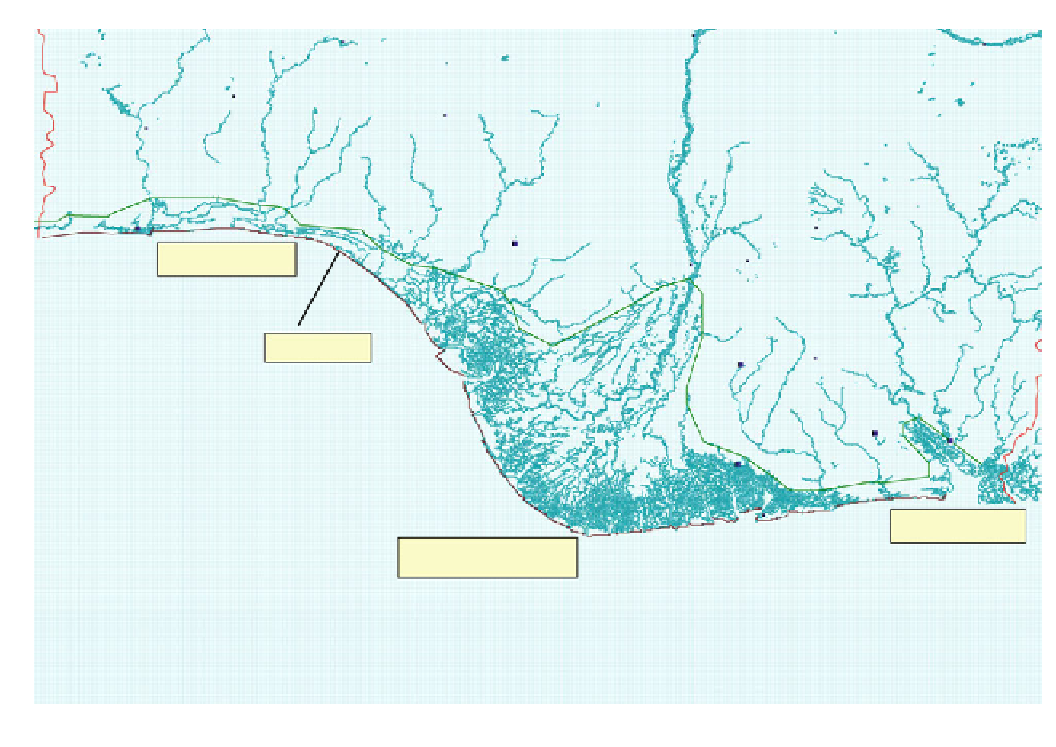Environmental Engineering Reference
In-Depth Information
3
4
5
6
7
8
N
Lagos
BeninCity
Barrier Coast
Cross River
Mahin
Coast
Estuary
Owerri
Uyo
Calabar
PortHarcourt
Bonny
Strand Coast
Niger Delta
Bonny
River
Estuary
0
200 Kilometers
Fig. 2
Location of Bonny and Cross River estuaries within the four Nigerian coastal morphological zones (after Awosika et al.
2000
)
estuary is the Bonny Island, one of the twenty barrier bar
islands (Allen
1964
) fronting the ocean in the Niger Delta.
The island is bordered by the Andoni River estuary in the
east and the Bonny River estuary in the west. The land-
scape, consisting of coastal plain sediments, is mostly flat
and low-lying in comparison with many other regions in
Nigeria. The coastal plain deposits are a mosaic of marine,
deltaic, estuarine, lagoonal and fluvio-lacustrine materials.
Bonny Island is relatively flat and consists of a series of
shallow sand ridges that indicate past regular seaward
accretion. Soils are generally sandy or sandy loam and the
natural soils are uncontaminated.
(NEDECO
1961
). The Bonny River system has the largest
tidal volume of all the river systems in the delta. There is
generally a net flux of tidal water up the river, which dis-
perses into various creeks and channels.
Vegetation
The vegetation along the estuary is made up of saline
mangroves, shrubs, creepers and climbers. There are
extensive brackish wetlands within which the mangrove
vegetation thrives. The mangroves occur mainly as thickets
and low woodlands. Both the thickets and the woodlands
contain varieties of mangrove species such as Rhizophora
racemosa, Rhizophora mangle and Rhizophora harrisonii as
well as Avicennia africana. However, the most prevalent
species is R. racemosa, which in an undisturbed state can
grow to a height of 30 m and above Isebor and Awosika
(
1993
). The root structures play an important role in the
stabilization of the sediments. Mangrove ecosystems in the
Bonny provide valuable physical habitat for various coastal
species such as shorebirds, wintering/migrating birds as well
as crabs, shrimps and juvenile stages of fish and shellfish.
There is also the presence of the Nympa palm (an introduced
Tidal Regime
Characteristically, the area is a typical tidal water zone with
little freshwater input but with extensive mangrove swamps,
inter-tidal mud flats, and influenced by a semi-diurnal tidal
regime. The tidal range in the Bonny River estuary is about
0.8 m at neap tides and 2.20 m during spring tides (NE-
DECO
1961
). Extreme tidal ranges of between 3.5 and
12.5 m are occasionally experienced at Bonny town, a
distance of about 15 km from the mouth of the estuary


























































































Search WWH ::

Custom Search